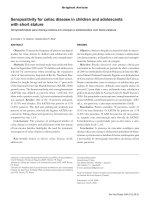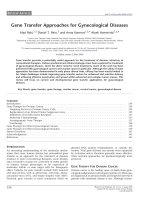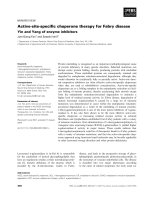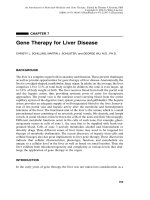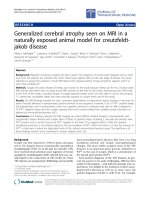thyroid surgery for graves’ disease
Bạn đang xem bản rút gọn của tài liệu. Xem và tải ngay bản đầy đủ của tài liệu tại đây (6.04 MB, 44 trang )
Thyroid Surgery for Graves’
Disease
Alexander Shifrin, MD
Department of Surgery
Jersey Shore University Medical Center
Case # 1
•
30 y.o. female with 5 year history of Graves’ disease
•
Treated with PTU x 2 years, came off, developed more
symptoms of hyperthyroidism plus dermatitis
•
Restarted on Methimazol, feels better
•
Unable to come off medications
•
Unable to get pregnant
•
Came for advice on therapy options?
•
Surgery – total
thyroidectomy (same day,
under local/regional block)
•
Path – multinodular goiter,
chronic thyroiditis c/w
Graves’ disease
2 weeks post op
Case # 1
Case # 2
•
43 yo f with Graves x 8 years. C/o inability to perform day-by-day
functions (stopped her martial arts, unable to catch her breath,
palpitations, anxiety).
•
Unable to come off of anti-thyroid meds
•
Developed 2cm, solid right thyroid
nodule (US 3/2008)
•
FNA Bx – negative for malig. cells
•
Fam Hx – neg; No h/o radiation
•
Surgery – total thyroidectomy (same
day, under local/regional block)
•
Path – follicular variant of papillary
thyroid carcinoma, 1 cm, no LN
2 weeks post op
Case # 3
•
57 y.o. female with 7 year history of Graves’ disease
•
Treated with Methimazol, can not come off of meds
•
f/u US (1/2008) - developed multinodular goiter with solid 3.8
cm cold nodule on Uptake scan + increased uptake throughout
the rest of the thyroid (43% @ 24hr)
•
compressive symptoms: swallowing, breathing difficulties in
supine position
•
Came for second opinion?
•
US guided FNA Bx – suspicious for papillary thyroid carcinoma
•
Surgery – (5/15/2008) total thyroidectomy (same day, under
local regional block)
•
Path – papillary and follicular variant of papillary thyroid
carcinoma, 1.8 x 1.6 cm
Case # 4
•
54 yo female, h/o Graves’ for 4 years.
•
Suffered of severe, panic disorder with intolerable anxiety
attacks, which precluded her daily life activities; problems with
people relationship, lost her job because of it. Anxiety was
worse when she was off thyroid meds.
•
Symptoms of difficulty swallowing solid – “stack in her throat”,
hoarseness, shortness of breath.
•
Thyroid US – MNG; Nuclear Med Thyroid Uptake - c/w Graves’.
•
TFT’s – wnl on Methimazol
•
Meds: Methimazol, Propronalol, Lexapro, Xanax
•
Fam Hx: Mother – thyroidectomy for goiter, breast Ca. Cousin –
thyroid Ca
Case # 4
•
Came for consultation with her friend – unable to control her
panic attacks, so her friend can speak for her. Very emotional,
constantly crying.
•
Surgery – total thyroidectomy.
•
Path – multinodular goiter
•
Follow-up in two weeks:
- panic attacks resolved
- stopped taking Xanax since surgery
only on Lexapro
- able to control her life, can deal with
problems without tears and emotion
- compressive symptoms resolved
(swallowing, breathing problems)
2 weeks post op
Toxic diffuse goiter
•
Robert James Graves – in the
English-speaking world
•
Carl Adolph von Basedow - in
continental Europe
Graves’ disease: facts
•
Autoimmune disorder with an unpredictable clinical course.
•
Symptoms directly related to hormone excess
•
Manifestations in connective tissue: Graves´ ophthalmopathy
and dermopathy
•
annual incidences: 40 per 100,000 in the US
•
4 to 6 times more common in females, mostly between age 20
to 50.
•
1% to 5% of patients with GD are children (peak at age 11 to 14
years)
Graves disease: facts
•
strong hereditary and genetic component
•
Smoking is weakly associated with GD but strongly with the
development of Graves ophtalmopathy
•
thyroid receptor antibodies activates the thyrotropin receptor
(TSHR), leading to synthesis and production of thyroid
hormones in the follicular cells and infiltration of lymphocytes
in the thyroid
1. Antithyroid medication
2. Radioactive iodine ablation (131I)
3. Thyroidectomy.
Indications vary based on geographical location:
•
Radioactive iodine ablation preferred in the US
•
Europe and Asia - antithyroid drugs or surgery are
favored.
Treatment options
Absolute indications for
surgery include the
following:
•
Presence of GD and an associated suspicious or
malignant thyroid nodule
•
Pregnancy, not controlled with antithyroid
medication
•
Local compressive symptoms
•
Children before age 5 yo
Is radioactive iodine safe?
No data for small dose (Graves’) but
there are date for iodine dose in
patients treated for thyroid cancer.
The Risk of Second Primary
Malignancies up to Three Decades
after the Treatment of Differentiated
Thyroid Cancer
Brown AP,Tward JD. J Clin Endocrinol Metab. 2008 Feb;93(2):504-15
•
METHODS: 30,278 patients with differentiated thyroid cancer (from
1973 to 2002) from centers participating in the NCI Surveillance,
Epidemiology, and End Results program.
•
Median follow-up - 103 months (2-359 months).
•
Risk was assessed for radioisotope therapy, gender, latency to
development of secondary cancer, and age at thyroid cancer
diagnosis.
The Risk of Second Primary Malignancies up
to Three Decades after the Treatment of
Differentiated Thyroid Cancer
Brown AP,Tward JD. J Clin Endocrinol Metab. 2008 Feb;93(2):504-
15
RESULTS:
•
2158 patients developed a total of 2338 nonthyroid second
primary malignancies, significantly more than that in the
general population [P < 0.05].
•
The increased risk was greater for the irradiated vs. the
unirradiated cohort (P < 0.05).
•
The greatest risk of second primary cancers occurred within 5
yr of diagnosis and was elevated for younger patients.
CONCLUSIONS:
The overall risk of second primary malignancies is increased
for thyroid cancer survivors and varies by radioisotope
therapy, latency, and age at diagnosis (leukemia, breast,
prostate).
Why not go straight to the surgery?
Is surgery safe?
What are side effects and
complications of the surgery?
Side effects/complications of the surgery
•
1-2 % risk or permanent RLN injury
(In non-thyroid specialized surgeon – up to 10-15% reported)
•
~15-20% risk of temporary hoarseness
•
Up to 15-20% chances of the EBSRN injury – high pitched voice
•
1-2% risk of permanent hypoparathyroidism
•
0.5 - 1% risk of bleeding
•
0.5 - 1% risk of infection
•
Scar
•
Lifelong thyroid replacement
Surgical Treatment of Graves' Disease: Evidence-Based
approach. Stalberg P, at al. World J Surg. 2008 Mar 8
•
The optimal treatment of Graves disease (GD) is still
controversial: antithyroid medication? vs radioactive iodine
(RAI)? vs Surgery?:
•
1) Is surgery better than RAI or long-term antithyroid
medication?
•
2) What is the recommended surgical approach?
•
3) How does the presence of Graves' ophthalmopathy (GO)
influence the role of surgery?
•
4) What is the role of surgery in children with GD?
•
METHODS: a systematic review of the literature using
evidence-based criteria regarding these four issues.
Surgical Treatment of Graves' Disease: Evidence-Based
approach. Stålberg P, at al. World J Surg. 2008 Mar 8
•
RESULTS:
•
1) There are no preference in the treatment options for adults.
•
2) Total thyroidectomy has same complication rates as subtotal,
but higher cure rates and negligible recurrence rates (grade A
recommendation).
•
3) If severe GO is present, surgery or RAI combined with
glucocorticoids (grade B recommendation).
•
4) The extent of thyroid resection does not influence the outcome
of GO (grade B recommendation).
•
5) RAI or surgery advocated for children (grade C
recommendation - lack of studies).
•
6) Increased cancer risk with RAI in children below the age of 5
years supports surgery in this setting (grade A
recommendation).
Surgical Treatment of Graves' Disease: Evidence-Based
Approach. Stålberg P, at al. World J Surg. 2008 Mar 8
•
CONCLUSION:
•
If surgery is considered - evidence-based criteria support total
thyroidectomy as the surgical technique of choice for GD.
•
Available evidence supports surgery in the presence of severe
GO.
•
Children with GD should be treated with an ablative strategy.
Whether total thyroidectomy or RAI - still debatable.
•
Data on long-term cancer risk are missing or conflicting; and
until RAI has proven harmless in children, we continue to
recommend surgery in this group.
How get patient ready for the safe
surgery?
The effect of anti-thyroid drug treatment duration on thyroid gland
microvessel density and intraoperative blood loss in patients with
Graves' disease.
Erbil Y et al. Surgery. 2008 Feb;143(2):216-25
•
Preoperative preparation of the patient with Graves' disease is
crucial to avoid intraoperative or postoperative complications
associated with anesthesia or surgery
•
43 patients were treated with Methimazole &/or Propylthiouracil,
preoperatively
•
Thyroid blood flow was measured by Doppler, microvessel
density was assessed immunohistochemically
•
CONCLUTION: Longer treatment duration had a 142-fold
decreased rate of intraoperative blood loss.
Effect of Lugol solution on thyroid gland blood flow and
microvessel density in the patients with Graves' disease.
Erbil Y et al J Clin Endocrinol Metab. 2007 Jun;92(6):2182-9
•
36 patients were randomly assigned to or not to receive
preoperative treatment with Lugol solution
•
Thyroid blood flow was measured by Doppler, microvessel
density was assessed immunohistochemically
•
Lugol solution treatment resulted in a 9.33-fold decreased rate
of intraoperative blood loss
•
CONCLUSION: Lugol decreased thyroid vascularity, and
intraoperative blood loss during thyroidectomy.
Total or subtotal thyroidectomy?
Total or subtotal thyroidectomy?
•
Equal rate of complications – RLN palsy (0.7% - 0.9%)
•
Equal rate of transient hypocalcemia (9.6% - 7.4%)
•
Equal rate of permanent hyporarathyroidism (0.9% - 1.0%)
•
Total thyroidectomy – no recurrence
•
Subtotal thyroidectomy – 7.9% recurrence
Palit. Et al 2000 J. Surg Res
Witte et al 2000 WJ Surg
•
Unpredictable rate of euthyroidism after subtotal (how mach to
leave?) up to 70% develops long term hypothyroidism
Michie 1975 Br J Surg
•
Micropapillary thyroid carcinoma found in 8% of patients with
GD
Stalberg. 2008 WJ Surg

